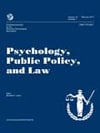
Exonerees who were wrongfully convicted based on false confessions were perceived to be less intelligent, more mentally ill, and more guilty – which impeded willingness to provide reintegration services. This is the bottom line of a recently published article in Psychology, Public Policy, and Law. Below is a summary of the research and findings as well as a translation of this research into practice.

Featured Article | Psychology, Public Policy, and Law | 2018, Vol. 24, No. 3, 341–352
Perpetually stigmatized: False confessions prompt underlying mechanisms that motivate negative perceptions of exonerees
Authors
Kyle C. Scherr, Central Michigan University
Christopher J. Normile, Central Michigan University
Heidi Putney, Central Michigan University
Abstract
Even in the fortunate instances of being exonerated of their wrongful convictions, exonerees often struggle to assimilate back into society. Although research has established that exonerees experience stigma and a general lack of reintegration support, little is known about underlying reasons that motivate such negative perceptions. This research examined whether the evidence and crime associated with a wrongful conviction could initiate a process that alters people’s perceptions of exonerees’ intelligence and mental health status, and, in turn, undermine people’s judgments of exonerees’ guilt and subsequent willingness to support reintegration services. Participants (N = 253) read a news story about an exoneree who was wrongfully convicted of either murder or grand theft auto resulting from either a false confession or eyewitness misidentification. Participants then offered their perceptions of the exoneree’s intelligence and mental health followed by guilt-confidence judgments. Last, participants indicated their willingness to support reintegration services (psychological counseling, career counseling, and job training). Results indicated that wrongful convictions stemming from a false confession caused people to perceive the exoneree as less intelligent and these judgments, in turn, were associated with perceptions that the exoneree suffered from mental health issues which, subsequently, influenced participants’ uncertainty of the exoneree’s innocence. The string of perceptions and judgments consequently undermined people’s willingness to support each of the reintegration services. The observed effects provide empirical evidence for reforms that automatically guarantee support services for exonerees in order to overcome potential biases aimed as those who have been wrongfully convicted.
Keywords
wrongful convictions, exonerees, false confessions, stigma
Summary of the Research
“Although our legal system is experiencing a proliferation of exonerations which has, in part, led to the identification of a variety of factors that are associated with wrongful convictions, these innocents continue to face many obstacles long after release. Yet, very little research has identified underlying mechanisms associated with certain factors that influence people’s willingness to support services that help exonerees effectively reintegrate into society. This research examined whether two evidential factors associated with wrongful convictions—false confessions and mistaken eyewitness identifications—and two crimes varying in their degree of perceived severity—murder and grand theft auto—prompt underlying mechanisms that may exacerbate the difficulties exonerees’ face upon release. Specifically, we tested the ability of these factors to initiate a series of judgments, from intelligence and mental health perceptions through persevering culpability perceptions, to undermine people’s willingness to support reintegration services necessary to help exonerees rematriculate back into society. Research illustrating the stigma exonerees face is offered next followed by a discussion of how the relevant evidence and crimes can impact the obstacles exonerees confront upon release.” (p. 341)
“A growing literature has established that exonerees continue to face substantial difficulties after being factually exonerated of their wrongful conviction. Exonerees are often viewed more negatively than a person with no criminal history and, in some instances, are perceived as negatively as parolees who are actually guilty of criminal wrongdoing. The stigma associated with being wrongfully convicted is also evident in people’s unwillingness to support reintegration reforms—such as psychological counseling, job training, and career counseling—to help exonerees transition back into functioning members of society. For some exonerees, people are especially reluctant to fully believe their innocence which, in turn, motivates a hesitancy to support reintegration services. […] Research is now beginning to identify factors that perpetuate these negative patterns. One factor leading to wrongful convictions—false confessions—has been found to especially influence exonerees’ experiences after release.” (pp. 341–342)
“False confessions are associated with up to 27% of DNA wrongful convictions and ~ 12% of wrongful convictions, in general. A robust body of literature has established myriad situational factors not attributable to the suspect, such as interrogation tactics and length of interrogations, that increase the risk innocent suspects will falsely confess. However, most people do not appreciate the situational pressures that can lead to false confessions and, in fact, believe they themselves would never falsely confess. To make sense of the counterintuitive idea of false confessions, most people make an internal, dispositional attribution to explain why innocent suspects admit to crimes they did not commit. […] Thus, when wrongful convictions stem from false confessions, people may be more likely to believe the person is responsible for the outcome (Why did they confess in the first place?) and may believe that only people who are unintelligent or have mental health issues would falsely confess.” (p. 342)
“Compared to false confessions, mistaken eyewitness identifications are associated with a higher percentage of wrongful conviction cases. Mistaken eyewitness identifications are associated with almost three quarters of DNA exonerations and ~ 30% of wrongful convictions, in general. […] However, although mistaken identifications are associated with a higher percentage of wrongful convictions, research has not found that individuals who are mistakenly identified are perceived in a similar negative manner to those who have falsely confessed. […] Instances of wrongful convictions resulting from false confessions, then, are likely perceived differently than wrongful convictions produced by mistaken eyewitness identifications. […] One aim of this research, therefore, was to examine whether wrongful convictions stemming from a false confession, compared to mistaken eyewitness identification, could alter people’s perceptions of exonerees’ intelligence and facilitate a process leading to subsequent negative perceptions and judgments.” (p. 342)
“People tend to hold a range of negative perceptions about individuals convicted of criminal wrongdoing. These assumptions depend on the criminal behavior and include beliefs that convicted individuals are aggressive, violent, antisocial, manipulative, crazy, insecure, and maladjusted. Because research suggests that most people continue to believe, to varying degrees, that exonerees are still guilty of the original, wrongful conviction, exonerees may often be subjected to a range of stereotypes and beliefs used to characterized guilty offenders. People’s negative perceptions of criminals also appear to extend to convicted perpetrators’ intelligence. […] Research suggests that these intelligence-based perceptions vary depending on the type of criminal wrongdoing. Whereas violent criminals (e.g., murder) are likely to be viewed as unskilled, uneducated, unintelligent, and immature, nonviolent criminals are likely to be perceived as more educated and deemed intelligent and smart. Taking these literatures into consideration suggests that exonerees who have been wrongfully convicted of violent crimes such as murder, and continue to be associated with violent crimes, may be perceived as unintelligent. On the other hand, exonerees who have been wrongfully convicted of nonviolent crimes, such as grand theft auto, seem less likely to be perceived as unintelligent.” (pp. 342–343)
“Based on extant literatures, we tested the perspective that exonerees who have falsely confessed and exonerees wrongfully convicted of a violent crime would be perceived as unintelligent and these intelligence perceptions, in turn, would predict perceptions that these exonerees’ suffered from mental health issues. Furthermore, we tested the possibility that perceiving exonerees’ as suffering from mental health issues could, subsequently, predict a reluctance to fully embrace exonerees’ innocence. Support for taking this sequential approach is offered by research establishing the strong relationship between people’s perceptions associating those with mental health issues as threatening and dangerous—perceived associations that have become stronger despite people reporting better understanding of mental health issues. […] We further tested the potential that any change in people’s perceptions of the exoneree and uncertainty of the exoneree’s innocence could ultimately influence people’s willingness to support reintegration services for the exoneree. Accordingly, this is the first research to test the possibility that intelligence and mental health perceptions can serve as underlying mechanisms that drive people’s distrust of exonerees’ innocence and unwillingness to fully support reintegration services. (p. 343)
“Based on the reviewed literatures, two hypotheses were examined. Although the following hypotheses are framed in terms of support for reintegration services as the outcome, three separate reintegration outcomes—psychological counseling, career counseling, and job training—were used. Each reintegration outcome was tested separately in an attempt to provide a more nuanced understanding of how people’s perceptions and judgments relate to specific reintegration aids. The False Confession hypothesis predicted that wrongful convictions stemming from a false confession, compared to mistaken eyewitness identifications, would result in (a) the exoneree being perceived as less intelligent, which would subsequently undermine people’s (b) perceptions of the exoneree’s mental health, and, in turn, their (c) willingness to fully acknowledge the exoneree’s innocence, and, consequently, (d) their willingness to fully support reintegration services for the exoneree. The Murder hypothesis predicted that wrongful convictions based on murder, compared to grand theft auto, would result in (a) the exoneree being perceived as less intelligent, which would subsequently undermine people’s (b) perceptions of the exoneree’s mental health, and, in turn, their (c) willingness to fully acknowledge the exoneree’s innocence, and, consequently, (d) their willingness to fully support reintegration services for the exoneree.” (p. 343)
Participants: 253 individuals (44.3% women) – mean age of 34.46 years with a standard deviation of 9.87; the majority were White. Participants were recruited using Amazon MTurk website.
“The study used a 2 (evidence: false confession vs. eyewitness misidentification) X 2 (crime: murder vs. grand theft auto) between-subjects design. Participants were randomly assigned to read one of four news stories regarding a wrongfully convicted man named Chris. Some participants read that Chris was wrongfully convicted of murder while others read that Chris was wrongfully convicted of grand theft auto. Whereas some participants were informed that Chris was wrongfully convicted based on a false confession, other participants were informed that Chris was wrongfully convicted based on a mistaken eyewitness identification. Participants’ offered their perceptions of Chris’s intelligence and mental health, guilt judgment and confidence in this judgment, willingness to support three reintegration outcomes (i.e., psychological counseling, career counseling, and job training), and then responded to informational and attention check items and demographic information.” (pp. 343–344)
“The results of this research extend the literatures bearing on wrongful convictions and are the first to illustrate underlying mechanisms that contribute to the obstacles many exonerees continue to face after release. The observed effects indicated that wrongful convictions stemming from false confessions initiate a series of processes that culminate in a decreased willingness to support efforts to help the exoneree reintegrate into society. People who were informed that an exoneree had falsely confessed perceived the exoneree as less intelligent which, in turn, was associated with people’s subsequent perceptions that the exoneree suffered from mental health issues, was not entirely innocent, and was less deserving of psychological and career counseling and job training.” (p.348)
“The observed effects also indicate that people’s perceptions of those they characterize as having mental health issues extend to culpability judgments. One possible reason, as alluded to earlier, stems from people’s perceptions connecting mental health issues with dangerousness, threat, and social distance. People may judge individuals who they perceive to have mental health issues as more culpable in order to justify incarcerating or committing these individuals to mental health units as ways to maintain order and safety. Although only approximately three percent of violent crimes are committed by individuals with a nonsubstance abuse related mental health issue, people continue to perceive mentally ill people as dangerous and violent. People who characterize an exoneree who falsely confessed as suffering from mental health issues may then continue to believe the exoneree is dangerous and violent and may resist believing the exoneree is entirely innocent as a way to maintain social distance and defend continued incapacitation.” (p. 349)
“Exonerees continue to face many obstacles upon release. One factor that can lead to wrongful convictions—false confessions—was found to prompt a process that motivates people to perceive the exoneree as less intelligent, likely suffering from mental health issues, not entirely innocent, and less deserving of reintegration services. These findings contribute to a growing literature establishing the need for, and use of, empirically based policy reforms to help the growing exoneree demographic. Building awareness of the issues leading to wrongful convictions, factors that contribute to exonerees’ struggles after release, and reforms that effectively help them rematriculate into society is imperative going forward.” (p. 350)
Translating Research into Practice
“The results of this study further demonstrate that people have reservations about supporting reintegration services for exonerees, particularly those who have falsely confessed. Perhaps because reforms and legislation have not mirrored the pace of exonerations, many states do not have explicit policies that address providing reintegration services for exonerees. Indeed, only 32 states, Washington, DC, and the federal government have statutes specifically for instances of wrongful conviction […] Policies need to be developed across the US that are supportive and overcome decision makers’ biases in order to beneficially aid all exonerees’ journeys to reintegrate back into their communities and rebuild their lives.” (p. 349)
“Accordingly, policies should be developed that guarantee exonerees access to reintegration services. The idea of providing automatic access to such services is especially important given the biases exonerees who have falsely confessed will face. Automatically providing all exonerees reintegration services circumvents such biases. […] many individuals who are released from prison struggle with mental health issues and exonerees struggle with unique psychological issues related to their wrongful conviction. Precluding certain exonerees (i.e., those who have falsely confessed) from guaranteed access to services constrains their ability to overcome any mental health issues engendered by the wrongful conviction.” (p. 349)
“Guaranteeing access to reintegration services is also critical to reducing the likelihood of future offenses because a fair percentage of exonerees who are released without access to reintegration services (~ 38%) commit at least one crime after release. […] In summary, when exonerees falsely confess and the wrongful conviction is based (fully or partly) on the confession, people remain reluctant to endorse supporting these individuals and some states in the US prevent these individuals from accessing reintegration services. Consequently, these exonerees are not able to obtain needed psychological services and training to become functioning members of society and are at an increased risk of becoming actual offenders.” (p. 349)
“Another straightforward policy recommendation focuses on guaranteeing that exonerees’ records are expunged of the wrongful conviction. Problematically, almost a third of one sample of exonerees found that exonerees’ records were not purged. […] Failures to expunge exonerees’ wrongful convictions provide an official record that people can search and use to defend stigmatizing and discriminating against some exonerees. A failure to expunge their record, due to living in a state that has a contributory provision preventing the false confessor from expungement, corroborates and reinforces the biased perceptions that may undermine professionals’ willingness to provide job training, career advice, and mental health services. […] In order to eschew such barriers and potential problems for exonerees, their wrongful conviction should automatically be expunged upon release regardless of contributory provisions.” (pp. 349–350)
Other Interesting Tidbits for Researchers and Clinicians
“Although the current research extends the literature on wrongful convictions and exonerees, there are some limitations that would be beneficial for future research to address. Being wrongfully convicted of murder did not initiate the series of negative perceptions and beliefs to the magnitude that was expected. Yet, the ability of certain crimes to precipitate negative perceptions and beliefs should be further investigated. It could be the case that certain crimes, regardless of perceived severity, only matter to the extent that they interact with other factors associated with the wrongful conviction.” (p. 350)
“Participants’ continued belief of the exoneree’s guilt was assessed using a combined measure of a binary culpability judgment multiplied by participants’ confidence in the judgment. This approach results in an outcome ranging from completely confident in the exoneree’s guilt (– 9) to completely confident in the exoneree’s innocence (+9). Overall, participants’ guilt-confidence judgments were positive indicating that, on average, people’s judgments trended more innocent than guilty. Nonetheless, this finding shows that people’s judgments were not all at + 9 (i.e., 100% confident in the exoneree’s innocence). This finding is troubling because, despite being informed that the exoneree was factually proven innocent via DNA evidence, participants did not, on average, believe the exoneree was entirely innocent. Furthermore, people were especially unwilling to entirely concede that the exoneree was innocent when he falsely confessed to the criminal wrongdoing. The fact that all participants’ guilt-confidence judgments were not at + 9 is meaningful because of its strong impact on people’s willingness to support necessary and important reintegration services for the exoneree. It would be beneficial for future research to precisely capture what degree people’s culpability beliefs have on people’s behaviors who heavily influence exonerees’ outcomes.” (p. 350)
“This research established some mechanisms that motivate several difficulties exonerees continue to face upon release. Still, many important questions remained unaddressed. One issue not addressed by this research is the ability of other risk factors associated with wrongful convictions (e.g., police and prosecutorial misconduct) to initiate a similar process that perpetuates the difficulties exonerees face. A related issue is the degree to which people are cognizant of their beliefs and judgments and the influence those beliefs and judgments have on exonerees. Identifying the degree to which both conscious and nonconscious beliefs and judgments influence people’s perceptions of, and behaviors toward, exonerees is imperative to developing effective policy reforms to help exonerees.” (p. 350)
Join the Discussion
As always, please join the discussion below if you have thoughts or comments to add!







